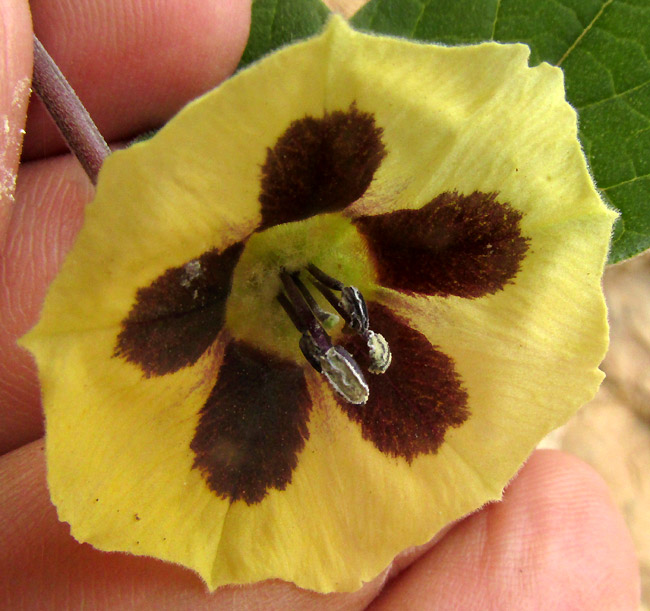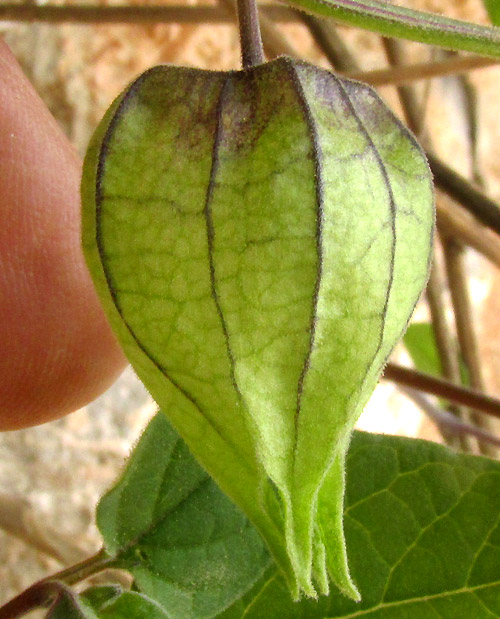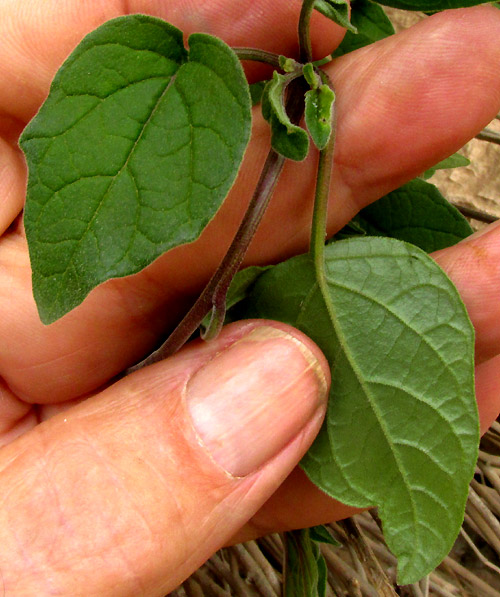Excerpts from Jim Conrad's
Naturalist Newsletter
Entry from field notes dated August 31, 2023, taken in Los Mármoles National Park in the Eastern Sierra Madre mountains, Hidalgo state, MÉXICO, along steeply climbing road heading eastward out of town of Trancas {on maps designated "Morelos (Trancas)"} toward Nicolás Flores; juniper/pine forest on limestone bedrock; elevation ~2,300m (~7,550ft); ~N20.80°, ~W99.25°
PHYSALIS ORIZABAE

The above handsome wildflower rooted in a crack of a vertical limestone wall beside the road. With dead branches of previous seasons dangling below, it's clearly a herbaceous perennial. The fairly large flowers somewhat hidden beneath their stems, directing downward their yellow faces with dark, star-shaped "eyes," is a striking feature.

Five blackish stamens arose from amid a cottony growth of hairs on the corolla tube's interior wall. The corolla tube abruptly flaired at its top creating a disc-like or rotate face.


The blossom's unusual, basket-shaped calyx hung upside-down bearing five long, slender, gradually tapering sepals. Note the dense covering of short hairs bent close to the surface of the calyx, pedicel and stems, a closer look provided at the right. In this group of plants, for identification purposes, it's important to note whether the hairs are branched and if so the nature of the branching, also their height and whether they are stiff and stick up, or soft and lie down, bear glands, or display other combinations of features. Our plant's hairs are generally distributed over the vegetating parts, but they're short, slender, bent close to the surface, not branched, and they lack glands.

If by now our plant hasn't revealed itself to you as a groundcherry or husk tomato of the genus Physalis, in the Black Nightshade/Tomato/Potato Family, the Solanaceae, the above picture of the Chinese-lantern like, bladdery husk enveloping the fruit should make clear that it is. The groundcherries or husk tomatoes, native to the Americas and Australasia, are common weeds, wildflowers and garden favorites. The tomatillo necessary for much of Mexican food preparation is a Physalis. Our plant's fruits were still immature and small, but here's what one looked like hanging inside its husk:

Finally, he leaves were fairly small and simple, with no teeth:

To enjoy "variations on the husk tomato theme," the best place in the world to be is Mexico. The 2023 study by Mahinda Martínez and others entitled "Taxonomic revision of Physalis in Mexico," tells us that the American genus of Physalis embraces about 90 species, with it center of diversity in Mexico, where 61 species are recognized. The 2022 work by José Luis Villaseñor entitled "Riqueza y distribución de la flora vascular del estado de Hidalgo, México" documents 28 Physalis species for our Hidalgo state in highland central Mexico. Among the species we've already appreciated are Physalis cinerascens, Physalis pubescens and Physalis nicandroides.
In our area, if you have an upright-growing, herbaceous perennial Physalis densely covered with rather short, simple hairs unaccompanied by glands, the flowers bear disc-like or rotate corollas, the stigma is flat-topped, or claviform, and the leaves bear no teeth, or maybe only two or three halfhearted attempts at teeth, you have PHYSALIS ORIZABAE, with no English name other than those generally applied to all Physalis -- groundcherry or husk tomato. Physalis orizabae is very similar to Physalis chenopodifolia, but the latter's densely white-hair leaves appear silvery, its leaves usually display three or more teeth, and its flowers average a little smaller.
Seeing such a handsome husk tomato emerging from a crack on a limestone wall, I thought the habitat and striking visual effect might indicate a rare species adapted for a special microhabitat. However, though Physalis orizabae is endemic just to Mexico, within Mexico it's widely distributed in highlands from the north all the way south to Oaxaca. The species is described as inhabiting slopes and margins of disturbed oak forests and adjacent clearings of pine-oak forests, disturbed grasslands and subtropical scrub. In other words, Physalis orizabae generally is somewhat weedy, and as such possesses flexible enough habitat requirements to prosper on a limestone wall.
Most Physalis species produce edible fruits, and being members of the Black Nightshade Family famous for containing potent alkaloids, they're likely to have histories of use as traditional medicines. The fruits of Physalis orizabae are edible, though other species provide larger ones. The 2009 study by Santiaguillo Hernández and others entitled "Aprovechamiento tradicional de las especies de Physalis en México" lists our "Physalis orizabae," as well as ten other Physalis species, as traditionally used to treat gastrointestinal discomforts and skin infections. Physalis orizabae is specifically mentioned for effective against diarrhea and, even more specifically, cholecystopathy, which is inflammation of the gallbladder.
Our plant's species name, orizabae, honors Pico de Orizaba, at 5636m (18,491ft), the highest mountain in Mexico, where the species was first collected scientifically.